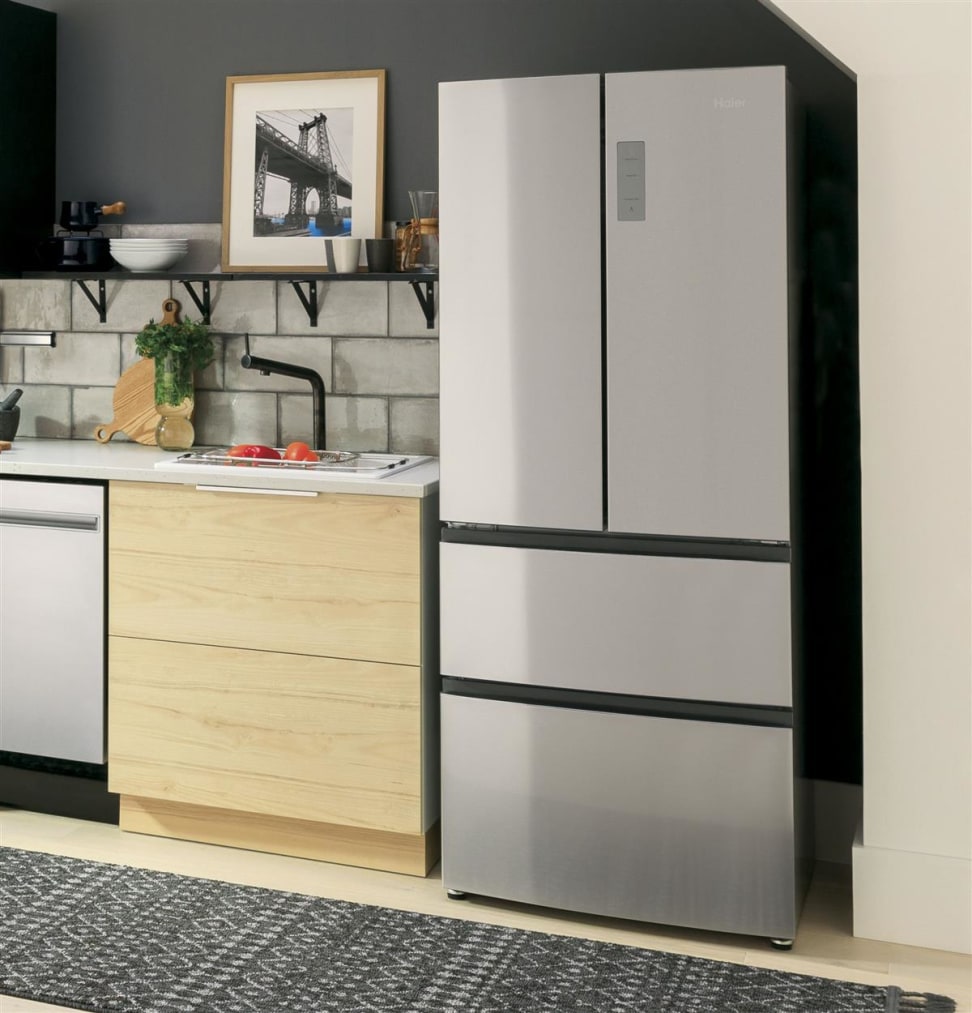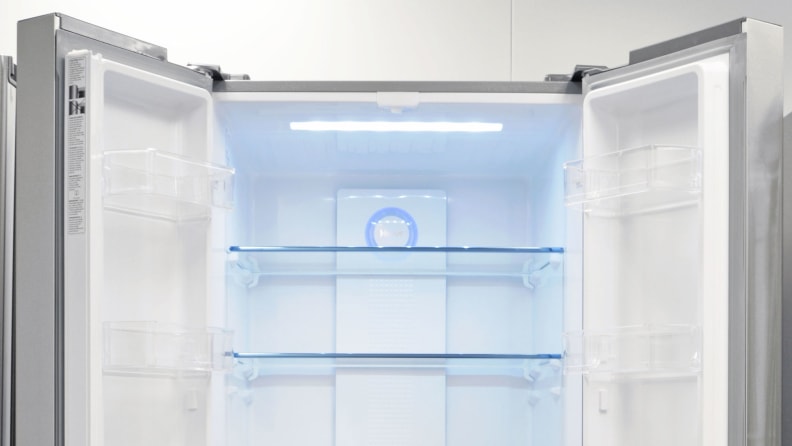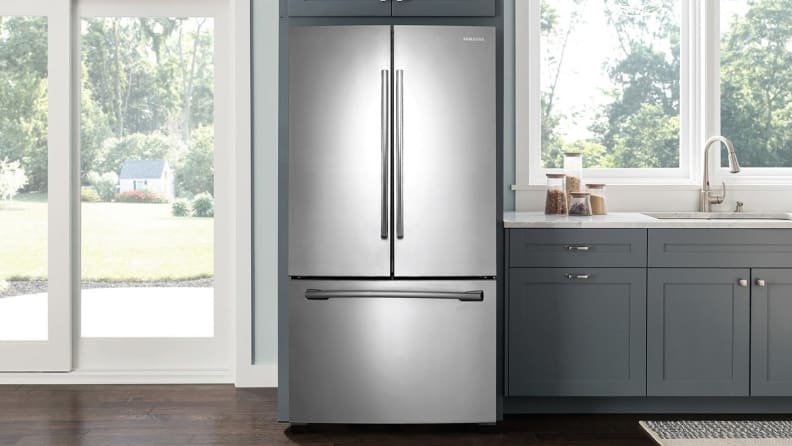The Best French-door Refrigerators Under $1,500 of 2022
 — Recommendations are independently chosen by Reviewed’s editors. Purchases you make through our links may earn us a commission.
— Recommendations are independently chosen by Reviewed’s editors. Purchases you make through our links may earn us a commission.French-door refrigerators aren't just convenient, they give your kitchen a designer look. Classy French-door models, with their handsome double doors, will keep more of your fresh food close to your eye level. The freezer drawer is great for keeping bulkier items accessible and closer to the ground.
If you know that a French-door refrigerator would elevate your kitchen, but worry that it would cost you an arm and a leg, let us reassure you. There are a number of French-door fridges that look great, keep your food appropriately cold, and are priced in the $1,500 range.
We've tested all the most popular French-door refrigerators on the market today in a range of different prices. Our exhaustive tests account for capacity, ease of use, and energy efficiency, too. That's how we can assure you that our top picks will work well for you.
Here, you'll find our top picks for French-door refrigerators that are affordably priced around $1,500. We recommend the sleek Haier HRF15N3AGS (available at Best Buy for $1,439.99) as the best overall option, which offers great performance at a low price.
These are the best French-door refrigerators under $1,500 we tested, ranked in order:
- Haier HRF15N3AGS
- LG LFCS22520S
- Haier HRQ16N3BGS
- Frigidaire FFBN1721TV
- Kenmore 73025
- Hisense HRF266N6CSE


Do you love the look and functionality of French-door refrigerators, but don't have the space to actually fit one in your kitchen? We have just the fridge for you: the Haier HRF15N3AGS. This fridge is considerably narrower and shallower than most French-door fridges; while that means you'll be able to fit it in a smaller kitchen, that also means you'll be able to fit less food in the fridge in the first place.
Because it's compact, the fridge itself is pretty bare-bones. There's no ice maker or water dispenser, and the shelves aren't very adjustable. The cooling on this fridge is top-notch, though, and it easily maintained fridge and freezer temperatures of 37°F and 0°F throughout our week of testing. If you don't need a lot of extra features and want to make the most of a relatively small kitchen, the Haier HRF15N3AGS compact French-door fridge is a great pick.
Pros
-
Slim profile
-
Consistent fridge temperatures
Cons
-
No through-door dispensers
-
Limited shelf adjustability
How We Test French-door Refrigerators Under $1,500
The Testers
Hi there! We're Reviewed's appliance testing team. Between the us, we've spent years testing major appliances including washers, dryers, refrigerators, dishwashers, vacuum cleaners, and robot vacuum cleaners.
We have plenty of experience testing these products in the lab, but we've also used them as normal people would in the course of our daily lives, which means that we have a great sense of what appliances are bargains at their price points, and which appliances have truly useful extra features.
The Tests
We test each fridge from two perspectives—first, from a data-driven, objective point of view, and second, as a regular person trying to get at the leftover Chinese food. The combination of these two types of experiences allows us to recommend the best fridge for you at any price point.
Refrigerators pull in air and cool it down to temperatures cold enough (usually around 37°F) to preserve food and limit bacterial growth. This cooling method means that fridges are very sensitive to air conditions. In hot weather, the condenser and cooling coils have to work harder to cool the warmer air. In cold weather, it may get so cold that the fridge condenser doesn’t turn on. This is why, if you happen to have a second fridge in your sweltering hot or freezing cold garage, you may have noticed that the air inside that fridge is not as cold as the air inside your kitchen fridge.
To avoid these temperature effects, we test each refrigerator in a lab that conditions the air temperature to 72°F +/- 5°F (basically, room temperature), and relative humidity to 50% RH +/- 15% RH. This way, each fridge can perform at its best, and doesn’t get penalized by dealing with warmer or colder air than its competitors.
We spend a week putting each refrigerator through its paces. After packing the fridge with water filled containers (fridges operate better when there’s less empty space), we measure the fridge’s temperature, humidity loss, freezing time, usable space, and energy use.
- Temperature — Our ideal temperature settings for the fridge and the freezer are 37°F and 0°F, respectively. With fridge temperatures higher than 37°F, you may have to start worrying about bacteria growth, as 40°F is the start of the bacteria “danger zone.” Food isn’t properly frozen at freezer temperatures above 0°F. Once we set each fridge to those temperatures, we collect temperature data throughout the week’s testing that tells us not only how close the temperature in the fridge and freezer are to 37°F and 0°F, respectively, but how close the air temperature stayed to those ideal values.
- Humidity Loss — For this test, we focus on the refrigerator’s veggie crisper. We add water to a floral foam ball, and measure how quickly it dries. Humidity matters because if the crisper is too dry, your leafy greens will quickly dry out. If the crisper is too humid, your fruits will rot. Fridges that strike a balance between the extremes will preserve your fruits and veggies for longer.
- Freezing Time — Once the fridge is plugged in, we measure the time it takes for the freezer to cool down from room temperature to 32°F (the freezing temperature of water). This is a good measure of how quickly your fridge and freezer can cool down food or beverages that have just been placed inside the refrigerator.
- Usable Space — One of the most common refrigerator specs is the total capacity, or the volume inside the fridge, in cubic feet. You’d think that a higher capacity means more storage, but that’s not always the case as shelves, drawers, and ice makers can eat into that capacity. We measure the usable space, which is how much empty space is actually available in the fridge’s interior to store your food and drinks.
- Energy Use — Using an electric meter, we measure the fridge’s energy usage (in Watt-hours) over the week of testing. The less energy used, the more efficient that fridge is, and the more money it’ll save you on utility bills in the future.
We also use each fridge in a more casual sense so that we can answer usability questions about the fridge’s specs and features, like the doors, shelves, controls, water/ice dispenser, and extras like smart connectivity, door-in-door or flexible storage options, etc. If a refrigerator keeps the temperature at a perfect 37°F, but it’s very difficult to open the doors and the control panel makes no sense, we’re going to penalize that fridge with respect to its ease of use.
What You Should Know Before Buying A French-door Refrigerator Under $1,500
What Is a French-door Refrigerator?

Traditionally, French doors are a set of double doors you'd have in your home, traditionally made out of glass, which allow a lot of natural light to shine through. In the context of fridges, however, a French door just means a pair of doors seal its refrigerator compartment.
This isn't to be confused with side-by-side fridges, which also have two doors, but in that instance the left door opens to a freezer and the right door opens to a fridge. French-door fridges, by contrast, have two doors over their main cabinet and typically have a drawer underneath for the freezer.
How Do You Organize a French-door Refrigerator?
While there's nothing special about organizing a French-door fridge compared to a normal fridge, it can still be a daunting task. We have a more in-depth guide that breaks down the process of cleaning and organizing your fridge, but we'll sum it up here.
The first step is to empty everything out and give the fridge a once-over with a soapy sponge. It's good to start with a blank canvas, and fridges get gross over time, even under the cleanliest circumstances.
Next it's a good idea to stock the door bins. Food here should be less perishable, as repeatedly opening the door throughout the day means items in door bins tend to run a bit warmer than other foods. Keep the perishable stuff towards the back of the fridge, where temperatures are most consistent.
It’s also important to keep your fruits and vegetables in separate crispers. Many fruits give off ethylene gas, which can exacerbate the ripening process for other fruits and vegetables. Keeping them separate will ensure the maximum shelf life for your leafy greens.
Finally, don't overstock. Your fridge needs to circulate cold air to keep everything at an appropriate temperature, and obstructing that air flow can create warm spots in the fridge where food can spoil much faster. Furthermore, cluttered fridges can often conceal food until long after its expiration date: Keeping things clean and organized will cut down on food waste.
What Temperature Should my French-door Refrigerator Be?
You should aim to keep your fridge at exactly 37°F and your freezer at 0°F.
Food needs to be kept within a very narrow band of temperatures to maximize its shelf life. If temperatures were just 5°F colder, at 32°F, some food in your refrigerator would start to freeze. Warming up by just 3°F gets you to 40°F, the temperature at which bacteria and fungi can proliferate more quickly.
It's the same story in your freezer. If temperatures are warmer than 0°F, it means your food isn't being truly frozen. Furthermore, if temperatures in your freezer aren't kept consistent, it can lead to your food periodically dethawing and refreezing, which greatly exacerbates the process of freezer burn.
How Long Do Refrigerators Last?
You should expect your fridge to last for about 10 years. Of course, several factors can limit the lifespan of your device, such as proper maintenance and keeping them in areas with relatively stable temperatures.
Most manufacturers' warranties cover one year of parts and service. Some companies will offer more robust programs that will cover specific parts up to five years, 10 years, or even for the lifetime of the product.
Other Affordable French-door Refrigerators We Tested

One of our favorite affordable French-door refrigerators is the LG LFC22520S. This fridge doesn’t have all of the bells and whistles you’ve seen on other new fridges, but with its spot on temperature performance, efficient operation, and sleek exterior, you won’t mind the lack of extra features.
The LFC22520S did an amazing job of maintaining ideal temperatures in the fridge and freezer; you won’t have to worry about the integrity of your milk or your leftovers. Its deep door bins, adjustable shelving, and extra storage drawer means you'll have plenty of options when it comes to storing groceries in the fridge cavity. While the crisper drawers didn’t maintain humidity levels as well as we’d hoped, we think that’s worth overlooking for its stellar temperature performance and storage options. For a French-door fridge that doesn’t break the bank, look no further than the LG LFC22520S.
Pros
-
Maintains even temperatures
-
10 year guarantee
Cons
-
Small storage capacity
-
No smart features


Haier knocks it out of the park again with the Haier HRQ16N3BGS, a unique French-door fridge with four doors. When it comes to temperature, this fridge does pretty well—the fridge can run a little warm at times, so be sure to bump down the temperature settings by a couple of degrees, but the freezer does just fine.
As for its fun, four-door design, the top two doors open to reveal the refrigerator, and the bottom two doors are for two separate freezer compartments. The freezer only has drawers, rather than shelves, so you won't be able to fit a frozen pizza box in here, but most smaller items and prepackaged meals should be fine. Because of this freezer limitation, though, we think that the Haier HRQ16N3BGS is best for homes with smaller families and/or a very organized person who does the grocery shopping.
Pros
-
Unique four-door design
-
Counter-depth
Cons
-
Fridge temperatures can run a little warm
-
Limited freezer space


The Frigidaire FFBN1721TV stands out for fantastic performance at its price point. On our temperature tests, we found it was capable of hitting ideal temperatures and holding them. We also like its crisper drawers, which will keep your leafy greens from wilting longer than the average fridge.
The one possible downside? Between this fridge being a bit on the small side and breaking its freezer into two compartments, its storage capacity is lower than average. Still, if storage space isn’t your #1 concern, there’s a lot to love about the FFBN1721TV.
Pros
-
Inexpensive
-
Solid temperatures
Cons
-
Low storage capacity
-
No dispensers or extras

The Kenmore 73025 stainless French-door fridge has all the right design choices to work for families with young children. The finish resists fingerprints, thick glass shelves contain the inevitable spills, and with two gallon-sized bins in the door, if your kids guzzle milk and juice, you have space to stock up. This model lacks a water dispenser, but think of it this way—no puddles on the kitchen floor. Finally, a child-height pantry drawer can dispense after-school snacks without requiring parental help.
Something else that makes this model shine: The fresh food compartment holds a very consistent, very safe temperature. Our tests show that the freezer isn't as consistent, with temperatures bouncing up and down some. That's still okay, if you mostly store frozen pizza and ice cream, because as you know, in a household with children, those don't last very long.
Pros
-
Fingerprint-resistant stainless steel
-
Great fridge temperature
-
Has kid friendly features
Cons
-
Inconsistent freezer temperature

Design-savvy consumers looking for a sleek, French-door refrigerator at a budget-friendly price should consider the Hisense HRF266N6CSE. With its matte finish and recessed handles, this is a smart-looking fridge for its price point. It also has more storage customizations than we typically see on other affordable fridges.
However, when it comes to performance, the HRF266N6CSE’s results can be mixed. While the temperature in its fridge is remarkably steady, its freezer temperature wobbles more than it should.
Pros
-
Sleek look
-
Internal ice and water dispensers
-
Consistent fridge temperatures
Cons
-
Inconsistent freezer temperatures
